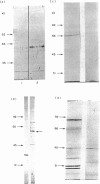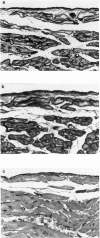Abstract
Polyclonal antibodies were raised in rabbits by immunization with free peptides corresponding to positions 197-222 of the human beta 1-adrenergic receptor (beta 1 peptide) and the corresponding sequence (172-197) of the human beta 2-adrenergic receptor (beta 2 peptide). While the beta 2 peptide yielded antibodies that cross-reacted with the beta 1 peptide, the antibodies against the beta 1 peptide did not cross-react with the beta 2 sequence. Cross-reactivity of the anti-beta 2 peptide antibodies and the selectivity of the anti-beta 1 peptide antibodies were also revealed in the recognition by immunoblots of the beta 1- and beta 2-adrenergic receptors of different species or of the receptor gene products expressed in a bacterial vector. These antibodies could be used immunohistochemically to visualize the beta-adrenergic receptors on rabbit heart. The anti-beta 2 peptide antibodies did not show any functional effect on the beta-adrenergic receptors; the anti-beta 1 peptide antibodies were able to displace agonist affinity to higher values. Recognition of truncated peptides by the anti-beta 1 and anti-beta 2 peptide antibodies suggested that the cross-reaction of the anti-beta 2 peptide antibodies was due to the recognition of a common epitope on the C-terminal part of the peptides. The anti-beta 1 peptide antibodies recognized the N-terminal part of the peptide better than the C-terminal part. These results suggest that the second extracellular loop postulated in the structure of the human beta-adrenergic receptor contains the T and B cell epitopes necessary for induction of an immune response. The selectivity and the functional properties of the antibodies raised against that loop in the beta 1 adrenergic receptor could have relevance in induction of auto antibodies in certain cardiomyopathic conditions.
Full text
PDF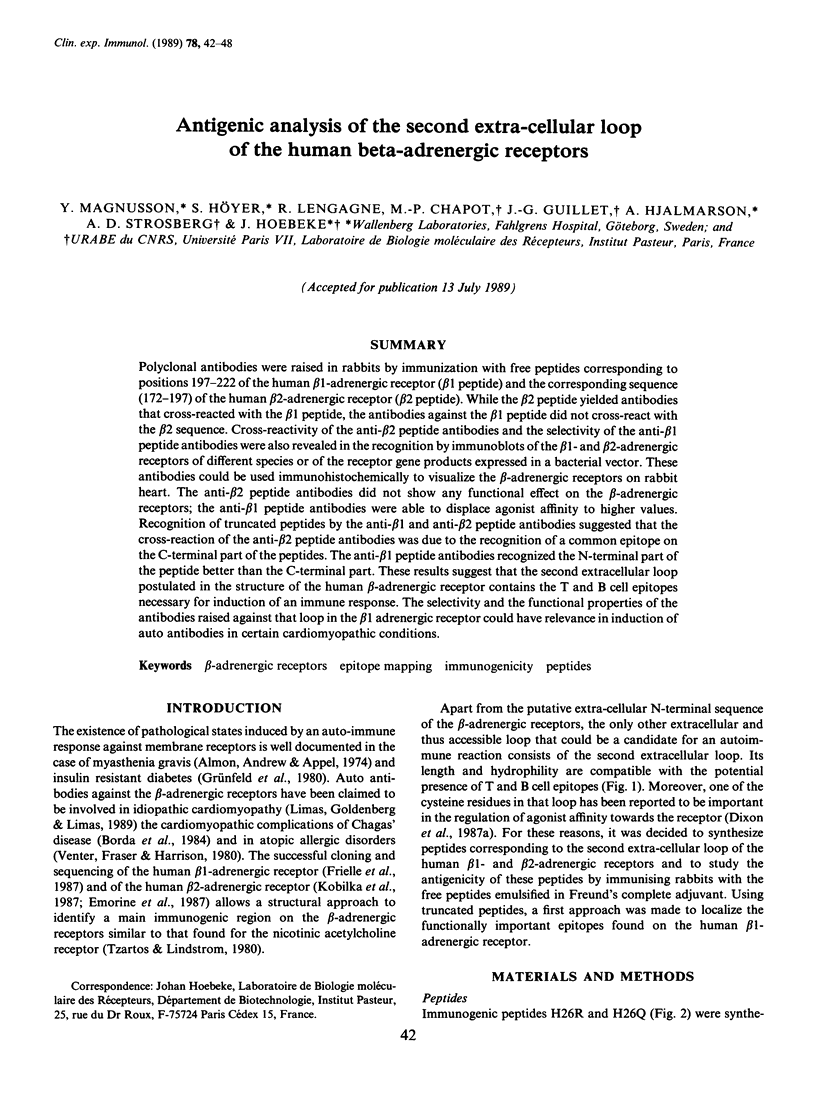
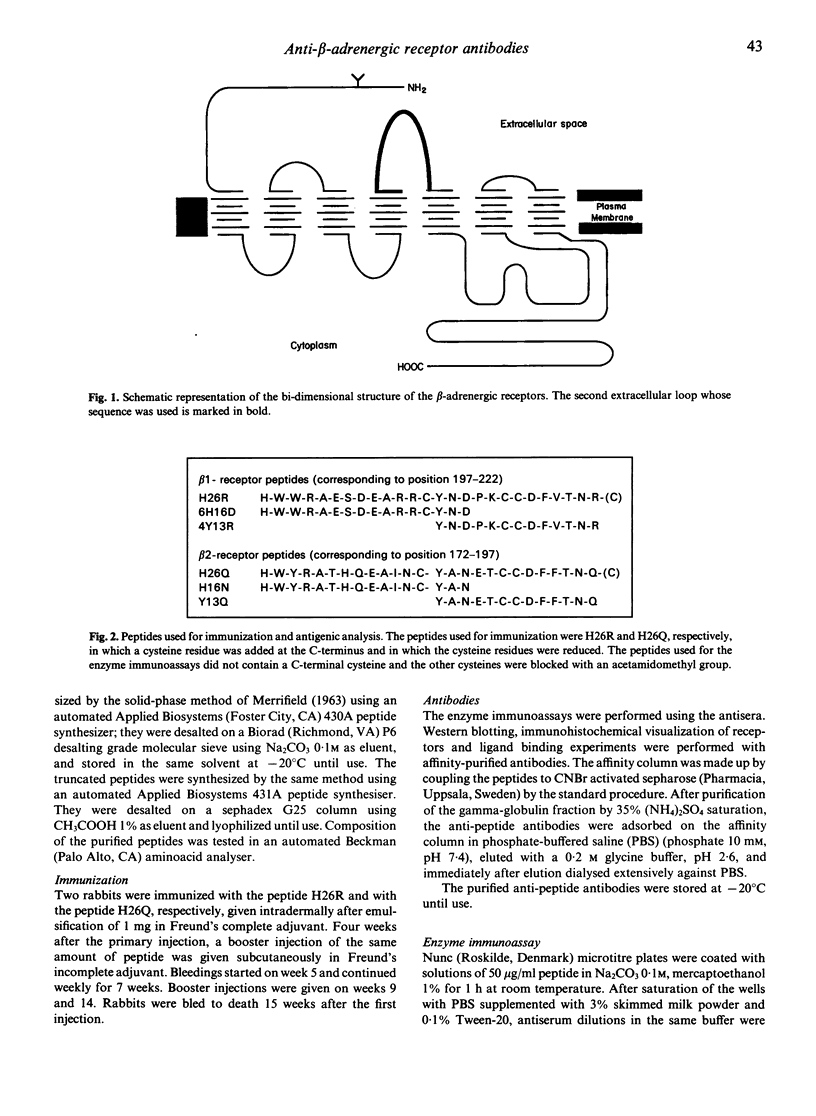


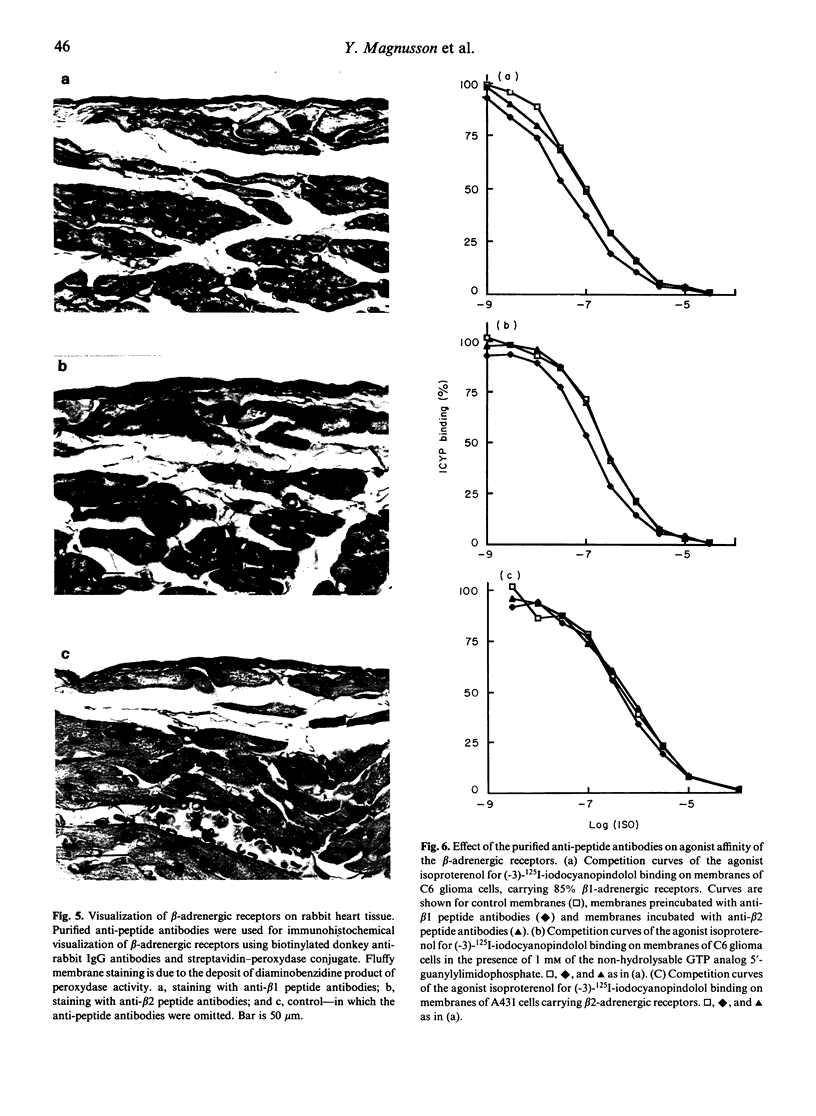
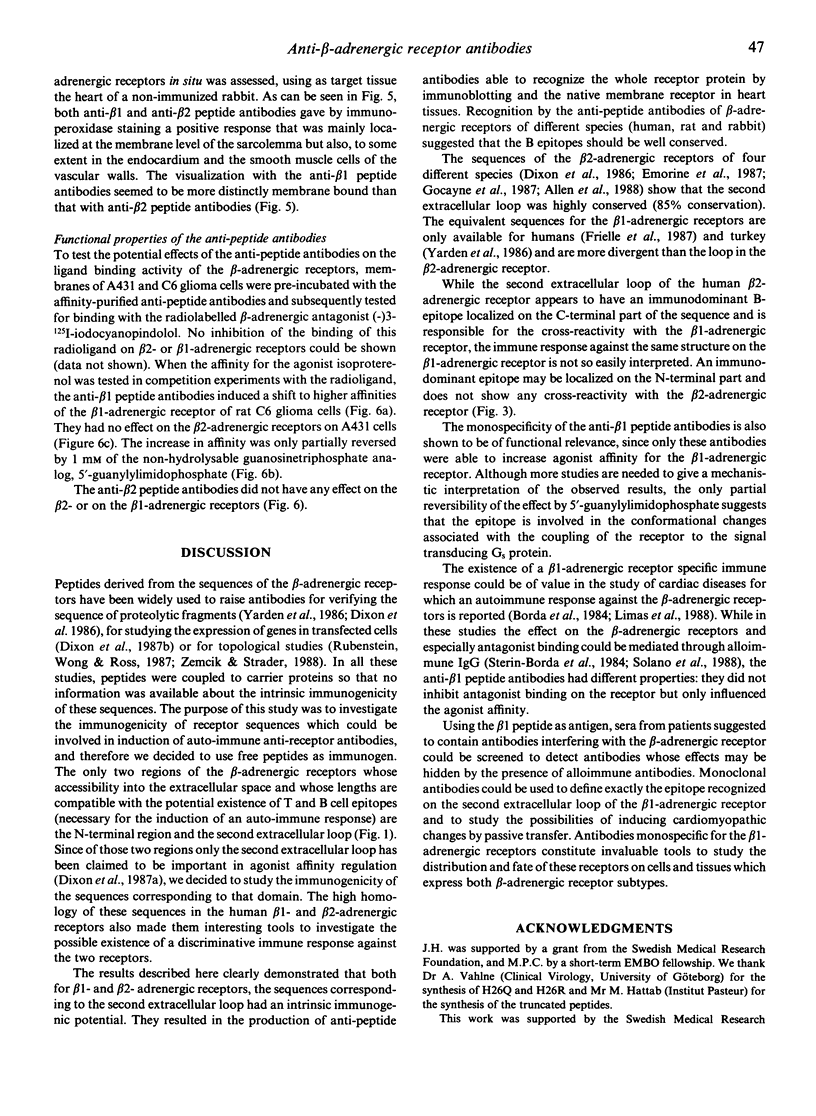
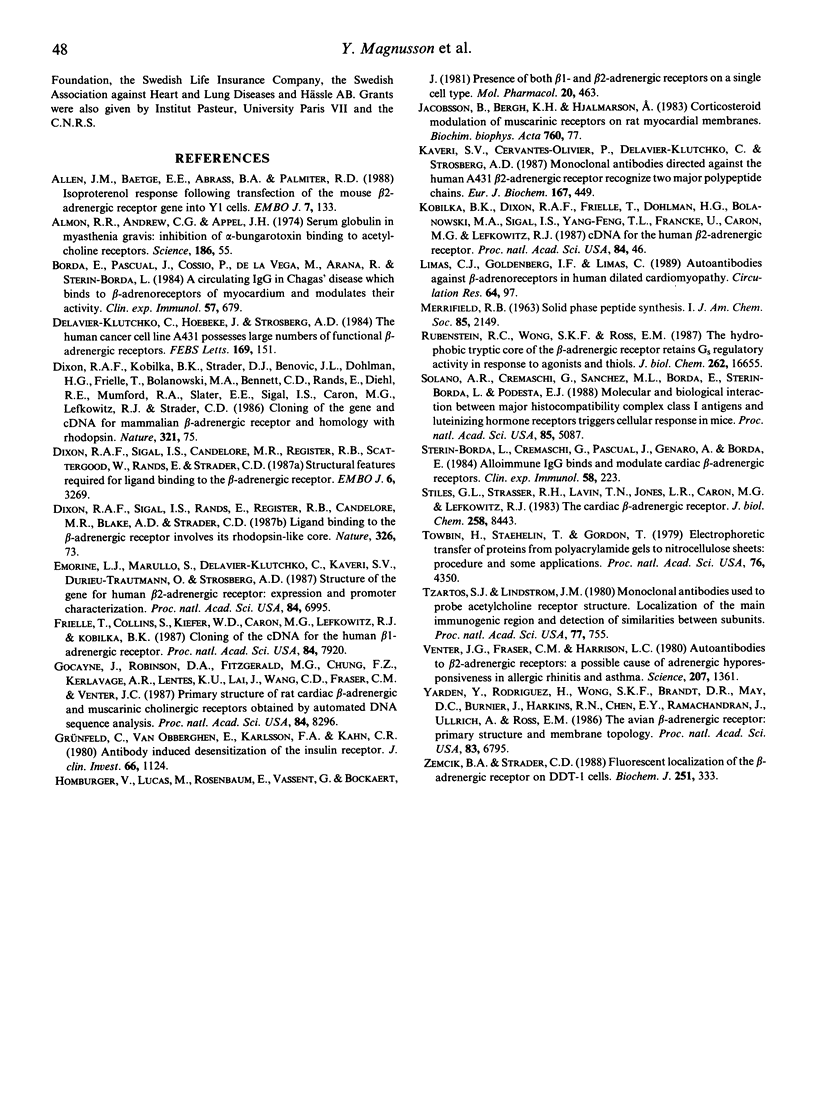
Images in this article
Selected References
These references are in PubMed. This may not be the complete list of references from this article.
- Allen J. M., Baetge E. E., Abrass I. B., Palmiter R. D. Isoproterenol response following transfection of the mouse beta 2-adrenergic receptor gene into Y1 cells. EMBO J. 1988 Jan;7(1):133–138. doi: 10.1002/j.1460-2075.1988.tb02792.x. [DOI] [PMC free article] [PubMed] [Google Scholar]
- Almon R. R., Andrew C. G., Appel S. H. Serum globulin in myasthenia gravis: inhibition of alpha-bungarotoxin binding to acetylcholine receptors. Science. 1974 Oct 4;186(4158):55–57. doi: 10.1126/science.186.4158.55. [DOI] [PubMed] [Google Scholar]
- Borda E., Pascual J., Cossio P., De La Vega M., Arana R., Sterin-Borda L. A circulating IgG in Chagas' disease which binds to beta-adrenoceptors of myocardium and modulates their activity. Clin Exp Immunol. 1984 Sep;57(3):679–686. [PMC free article] [PubMed] [Google Scholar]
- Delavier-Klutchko C., Hoebeke J., Strosberg A. D. The human carcinoma cell line A431 possesses large numbers of functional beta-adrenergic receptors. FEBS Lett. 1984 Apr 24;169(2):151–155. doi: 10.1016/0014-5793(84)80308-7. [DOI] [PubMed] [Google Scholar]
- Dixon R. A., Kobilka B. K., Strader D. J., Benovic J. L., Dohlman H. G., Frielle T., Bolanowski M. A., Bennett C. D., Rands E., Diehl R. E. Cloning of the gene and cDNA for mammalian beta-adrenergic receptor and homology with rhodopsin. Nature. 1986 May 1;321(6065):75–79. doi: 10.1038/321075a0. [DOI] [PubMed] [Google Scholar]
- Dixon R. A., Sigal I. S., Candelore M. R., Register R. B., Scattergood W., Rands E., Strader C. D. Structural features required for ligand binding to the beta-adrenergic receptor. EMBO J. 1987 Nov;6(11):3269–3275. doi: 10.1002/j.1460-2075.1987.tb02645.x. [DOI] [PMC free article] [PubMed] [Google Scholar]
- Dixon R. A., Sigal I. S., Rands E., Register R. B., Candelore M. R., Blake A. D., Strader C. D. Ligand binding to the beta-adrenergic receptor involves its rhodopsin-like core. Nature. 1987 Mar 5;326(6108):73–77. doi: 10.1038/326073a0. [DOI] [PubMed] [Google Scholar]
- Emorine L. J., Marullo S., Delavier-Klutchko C., Kaveri S. V., Durieu-Trautmann O., Strosberg A. D. Structure of the gene for human beta 2-adrenergic receptor: expression and promoter characterization. Proc Natl Acad Sci U S A. 1987 Oct;84(20):6995–6999. doi: 10.1073/pnas.84.20.6995. [DOI] [PMC free article] [PubMed] [Google Scholar]
- Frielle T., Collins S., Daniel K. W., Caron M. G., Lefkowitz R. J., Kobilka B. K. Cloning of the cDNA for the human beta 1-adrenergic receptor. Proc Natl Acad Sci U S A. 1987 Nov;84(22):7920–7924. doi: 10.1073/pnas.84.22.7920. [DOI] [PMC free article] [PubMed] [Google Scholar]
- Gocayne J., Robinson D. A., FitzGerald M. G., Chung F. Z., Kerlavage A. R., Lentes K. U., Lai J., Wang C. D., Fraser C. M., Venter J. C. Primary structure of rat cardiac beta-adrenergic and muscarinic cholinergic receptors obtained by automated DNA sequence analysis: further evidence for a multigene family. Proc Natl Acad Sci U S A. 1987 Dec;84(23):8296–8300. doi: 10.1073/pnas.84.23.8296. [DOI] [PMC free article] [PubMed] [Google Scholar]
- Grunfeld C., Van Obberghen E., Karlsson F. A., Kahn C. R. Antibody-induced desensitization of the insulin receptor. Studies of the mechanism of desensitization in 3T3-L1 fatty fibroblasts. J Clin Invest. 1980 Nov;66(5):1124–1134. doi: 10.1172/JCI109942. [DOI] [PMC free article] [PubMed] [Google Scholar]
- Homburger V., Lucas M., Rosenbaum E., Vassent G., Bockaert J. Presence of both beta1- and beta2-adrenergic receptors in a single cell type. Mol Pharmacol. 1981 Nov;20(3):463–469. [PubMed] [Google Scholar]
- Jacobsson B. A., Bergh C. H., Hjalmarson A. Corticosteroid modulation of muscarinic receptors in rat myocardial membranes. Biochim Biophys Acta. 1983 Oct 4;760(1):77–83. doi: 10.1016/0304-4165(83)90126-5. [DOI] [PubMed] [Google Scholar]
- Kaveri S. V., Cervantes-Olivier P., Delavier-Klutchko C., Strosberg A. D. Monoclonal antibodies directed against the human A431 beta 2-adrenergic receptor recognize two major polypeptide chains. Eur J Biochem. 1987 Sep 15;167(3):449–456. doi: 10.1111/j.1432-1033.1987.tb13358.x. [DOI] [PubMed] [Google Scholar]
- Limas C. J., Goldenberg I. F., Limas C. Autoantibodies against beta-adrenoceptors in human idiopathic dilated cardiomyopathy. Circ Res. 1989 Jan;64(1):97–103. doi: 10.1161/01.res.64.1.97. [DOI] [PubMed] [Google Scholar]
- Rubenstein R. C., Wong S. K., Ross E. M. The hydrophobic tryptic core of the beta-adrenergic receptor retains Gs regulatory activity in response to agonists and thiols. J Biol Chem. 1987 Dec 5;262(34):16655–16662. [PubMed] [Google Scholar]
- Solano A. R., Cremaschi G., Sánchez M. L., Borda E., Sterin-Borda L., Podestá E. J. Molecular and biological interaction between major histocompatibility complex class I antigens and luteinizing hormone receptors or beta-adrenergic receptors triggers cellular response in mice. Proc Natl Acad Sci U S A. 1988 Jul;85(14):5087–5091. doi: 10.1073/pnas.85.14.5087. [DOI] [PMC free article] [PubMed] [Google Scholar]
- Sterin-Borda L., Cremaschi G., Pascual J., Genaro A., Borda E. Alloimmune IgG binds and modulates cardiac beta-adrenoceptor activity. Clin Exp Immunol. 1984 Oct;58(1):223–228. [PMC free article] [PubMed] [Google Scholar]
- Stiles G. L., Strasser R. H., Lavin T. N., Jones L. R., Caron M. G., Lefkowitz R. J. The cardiac beta-adrenergic receptor. Structural similarities of beta 1 and beta 2 receptor subtypes demonstrated by photoaffinity labeling. J Biol Chem. 1983 Jul 10;258(13):8443–8449. [PubMed] [Google Scholar]
- Towbin H., Staehelin T., Gordon J. Electrophoretic transfer of proteins from polyacrylamide gels to nitrocellulose sheets: procedure and some applications. Proc Natl Acad Sci U S A. 1979 Sep;76(9):4350–4354. doi: 10.1073/pnas.76.9.4350. [DOI] [PMC free article] [PubMed] [Google Scholar]
- Tzartos S. J., Lindstrom J. M. Monoclonal antibodies used to probe acetylcholine receptor structure: localization of the main immunogenic region and detection of similarities between subunits. Proc Natl Acad Sci U S A. 1980 Feb;77(2):755–759. doi: 10.1073/pnas.77.2.755. [DOI] [PMC free article] [PubMed] [Google Scholar]
- Venter J. C., Fraser C. M., Harrison L. C. Autoantibodies to beta 2-adrenergic receptors: a possible cause of adrenergic hyporesponsiveness in allergic rhinitis and asthma. Science. 1980 Mar 21;207(4437):1361–1363. doi: 10.1126/science.6153472. [DOI] [PubMed] [Google Scholar]
- Yarden Y., Rodriguez H., Wong S. K., Brandt D. R., May D. C., Burnier J., Harkins R. N., Chen E. Y., Ramachandran J., Ullrich A. The avian beta-adrenergic receptor: primary structure and membrane topology. Proc Natl Acad Sci U S A. 1986 Sep;83(18):6795–6799. doi: 10.1073/pnas.83.18.6795. [DOI] [PMC free article] [PubMed] [Google Scholar]
- Zemcik B. A., Strader C. D. Fluorescent localization of the beta-adrenergic receptor on DDT-1 cells. Down-regulation by adrenergic agonists. Biochem J. 1988 Apr 15;251(2):333–339. doi: 10.1042/bj2510333. [DOI] [PMC free article] [PubMed] [Google Scholar]



